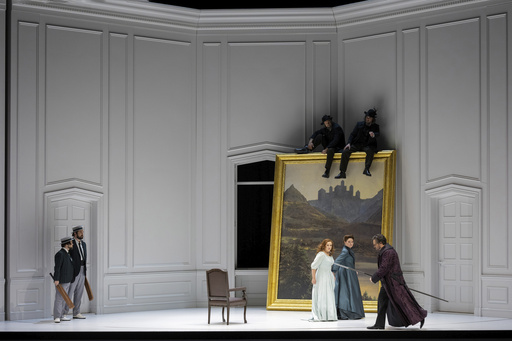ZURICH (AP) — In an age of radical reinterpretations, conductor Gianandrea Noseda and director Andreas Homoki created a counterrevolutionary version of Wagner’s four-night, 15-hour Ring Cycle that sparked 13 minutes of applause at the Zurich Opera House.
Noseda, conducting Wagner’s epic for the first time just after his 60th birthday, was drenched in sweat as if emerging from a swimming pool when he invited the entire Philharmonic Zurich on stage to join the cast for curtain calls on Thursday night.
Wagner has been dominated by regietheater since Patrice Chéreau’s seminal staging for the 1976 Bayreuth Festival recast the story of gods, humans, giants and dwarfs through the lens of the Industrial Revolution. While avoiding a strict adherence to Wagner’s original instructions, Homoki used relatively minimal if dull scenery to allow a psychological focus without distraction. His Wotan is a self-loathing head god who collapses, his entire body shaking, realizing the disasters are of his own doing.
“For me this Ring here is one of the most intelligent Rings because we tell the story, and the story is really not that stupid like the modern directors think,” said bass-baritone Tomasz Konieczny, who has sung Wotan in 20 different productions.
Noseda committed to the Ring with Homoki in 2018 as part of an agreement to succeed Fabio Luisi as music director. Noseda studied in 2020 during the pandemic for five hours daily in segments, at 3 a.m. and 2 p.m.
“The world of the Ring is an ocean. It’s not even a Mediterranean Sea,” Noseda said. “You have to be able to dive, to get up and to swim and to feel yourself at ease.”
Noseda took advantage of the venue, an 1,100-seat house less than half the size of other major theaters, to create an eloquent environment in which Wagnerians used to belting for the rafters could sing softly at each other. He used two harps instead of six for “Das Rheingold,” the opening night of “Der Ring des Nibelungen (The Ring of the Nibelung),” and four double basses rather than eight.
“You don’t need more in this hall,” Noseda said. “The pit is not hugely big, so you can fit a certain number of musicians. In a way, it makes the flavor of the experience more intimate.”
The second of the two cycles will be streamed live for free on the Zurich Opera’s website from May 18-26 and then be available for replay, with additional distribution on the Medici streaming service and a DVD release.
Homoki was met with only one or two boos during curtain calls in an age when a sizeable segment of the audience often jeers Wagner directors. He had spent three or four hours on Skype daily with dramaturg Werner Hintze in early 2020 discussing ideas.
“We understood this piece as being just a story about human nature, about society, about us,” Homoki said. “I don’t want to be misunderstood as somebody who is trying to object to contemporary, interpretations. I think a contemporary interpretation is this. It just has to work.”
Collaborating with set and costume designer Christian Schmidt and lighting designer Franck Evin, Homoki placed all four nights on a turntable shifting from forest to a Valhalla mansion. Whimsical elements included Valkyries with horses’ heads as helmets and Rhinemaidens in pajamas with Marilyn Monroe platinum wigs.
They configured the gods Froh (Omer Kobiljak) and Donner (Xiameng Zhang) as toffs in boating blazers with cricket bats, and Gibichung twins Gutrune (soprano Lauren Fagen) and Gunther (baritone Daniel Schmutzhard) in groovy red jackets that would have fit in Austin Powers’ movies. Loge (tenor Matthew Klink) could have been a body double for Johnny Depp.
“It’s just space as if you are in heaven, where there’s not time,” Homoki said. “The piece is conceived for a stage esthetic of 170 years ago. You don’t want to see any of those performances that people saw at the time. You have to see it from today’s eye. Sometimes you have to just clear away the rubbish and then people say, oh no, it was just the rubbish that we loved so much. OK, then too bad.”
Wotan is on stage for the opening of “Die Walküre,” an act earlier than Wagner wrote, making sure Siegmund and Sieglinde meet in the forest, then handing mead to her to give to her brother and future lover. For the Immolation Scene that ends “Götterdämmerung (The Twlight of the Gods),” Brünnhilde imagines Siegfried coming back to life and accompanying her to his funeral pyre.
“This was a big gift, that I don’t have to do crazy things but only the things that fit to my character,” said tenor Klaus Florian Vogt, who sang a robust Siegfried.
Konieczny was a commanding Wotan and soprano Camilla Nylund an endearing Brünnhilde (this production was her role debut). Soprano Daniela Köhler was a vocally gripping Sieglinde and bass-baritone Christopher Purves a menacing Alberich, their acting and singing riveting in the compact space. Bass David Leigh (Hagen) showed to be a top emerging talent.
Siena Licht Miller (Flosshilde) and her fellow Rhinemaidens added comic touch. She appreciated Homoki eschewing gimmicks.
“He’s really interested in every person in the audience understanding the piece and in particular with the text in a German-speaking country,” she said. “Eurotrash — we make fun of it, and we watch in school. There are moments where you can see that it really works, but if it’s just trying to help the audience be more entertained, it’s a cop out.”
This website uses cookies so that we can provide you with the best user experience possible. Cookie information is stored in your browser and performs functions such as recognising you when you return to our website and helping our team to understand which sections of the website you find most interesting and useful.
